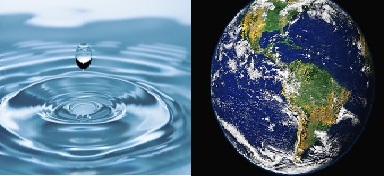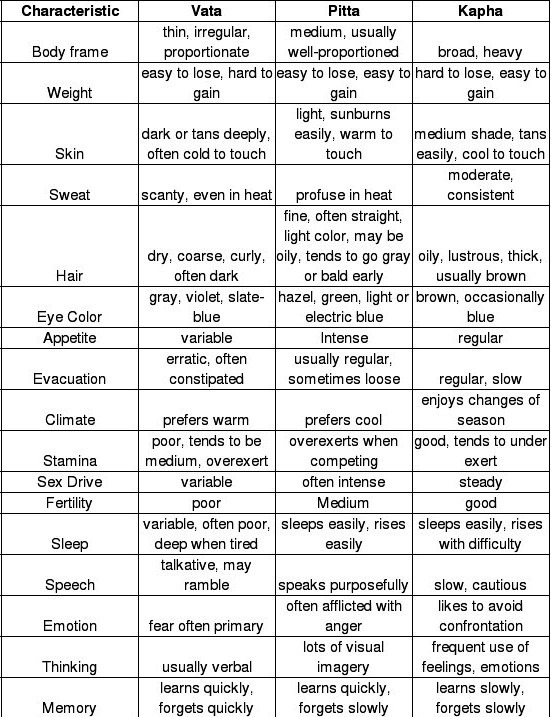If you have a health problem and want an alternative solution, or if you are healthy and want to know your body/mind type and how to maintain your health, Read this complete article and find what dosha effect your body.
What is dosha ?
 According to Ayurveda, there are three primary life forces in the body called doshas. The doshas bind the five elements – air, ether, fire, water and earth into living flesh. In Sanskrit these are called Vata, Pitta Kapha. They are the active and mobile elements that determine the life processes of growth and decay. Dosha means that which darkens, spoils or causes things to decay – for when out for balance, they are the forces in the disease process.
According to Ayurveda, there are three primary life forces in the body called doshas. The doshas bind the five elements – air, ether, fire, water and earth into living flesh. In Sanskrit these are called Vata, Pitta Kapha. They are the active and mobile elements that determine the life processes of growth and decay. Dosha means that which darkens, spoils or causes things to decay – for when out for balance, they are the forces in the disease process.
What is Vata Dosha?
Vata happens in the lower part of the abdomen when its balance worsens, such diseases occur to us as there is pain in the body, and there are no incestious diseases.
People with Vata dosha dominating in their lives are governed mostly by the key characteristic of Vata, which is movement. Movement implies change, and changeability, and Vata dosha people have plenty of both. They tend to complete activity quickly, to change from one activity to another both frequently and rapidly. Their moods and emotions shift rapidly, and their minds tend to be restless and inconstant.
Because of the power of the force of movement, Vata people will use up whatever energy they have on whichever of the many interesting possibilities strike their fancy at the moment; expending energy until there is nothing left in the reservoir, at which time they must retire while waiting for a new store of energy to accumulate. Their physical bodies change rapidly too: digestion may be excellent on one day, and poor the next; sleep may be deep and sound at times, and light or non-existent at others. Vata energy is made up of endless cycles of boom and bust, the boom full of creativity, learning, action and enthusiasm, the bust the quiet time of recuperation and retreat.

Symptoms of Vata dosha.
Because Vata dosha carries the quality of dryness, Vata people tend to have dry skin which is rough and cracks, joints which creak and pop, and constipation is often present. They are more cold blooded than Pitta or Kapha people, and so tend to love heat, light, and hot weather, and can suffer miserably in cold climates (especially cold, dry, windy climes). They are usually thin, and find it difficult to gain weight.

This factor, coupled with irregular and changeable eating habits often leads to cellular anxiety due to the erratic supply of nutrients they receive, which in turn can create fear and anxiety as the dominant negative emotion for Vata people. They have imaginative minds, are exciting and excitable, and can be both extroverted and introverted. Vata is the most difficult constitution to keep healthy due to the excessive patterns of energy use, but when balanced, a Vata person is a good creative and original thinker, mentally alert, may be inspired, and is quick to process and imagine.
Factors responsible for increasing Vata dosha:
- Eating too much cabbage, cauliflower, broccoli, sprouts, beans, dry fruits, mushrooms and raw foods.
- Too much traveling by any means of transportation.
- Staying awake till late night or not sleeping at all.
- Eating of junk food, frozen foods and food that has been micro waved.
- Excessive exposure to high noise level or high sounds.
- Watching too much television and over exposure to computers or any other kind of electric gadgets from strong waves are emitted.
- Indulging in too much sexual activities.
- Excessive imagination, overworking or too much sports.
- Taking too much medicinal, recreational and stimulating drugs, etc.
How to balance Vata dosha?
To keep balanced, a Vata may be advised to:
- Keep warm
- Choose a Vata dosha pacifying diet
- Develop and stick to a daily routine which includes gentle exercises and is sensitive to Vata times of day and year
- Avoid over stimulation, worry and fear, cold food and drink
- Develop and reinforce sincere affection for others and devotion to life.
What is Pitta dosha?
Pitta is a type of digestive juices but it is also poison. Pitta is a fluid that improves digestion, with its imbalance in the stomach complains of constipation and gas as well as the brain is also affected, so it is necessary to maintain balance.Its taste is bitter. Bile function is important in digestion.
This makes digestive juices active, as well as when it is in the gall bladder, it does not have the power to stop it from rotting, but by reaching the intestines, it prevents food from rotting early. Apart from this, it helps to remove the toxin from the body. The Pitta dosha is formed in the liver and the cheeks are stored in bladder. It contains 80-90 percent water and the remaining 10-20 percent is salt, fat, muscus and inorganic salt. Pitta stimulates other digestive juices of the body, which means enhances their functioning. Therefore it is very important to maintain balance.
Pitta dosha people are governed largely by the quality of heat, which gives them warm, soft skin which will generate freckles, rashes, pimples, moles and wrinkles more readily than Kapha or Vata dominant types. They tend to dislike heat, preferring cold climates, enjoying winter sports, and gravitating to cooling foods (unless they have become addicted to the stimulation of hot, spicy food). They are efficient and precise in their mentation and physical orientations, and can be strong-willed, opinionated, and forceful with their ideas and actions. Their innate heat makes them easily irritated, tending to intolerance of disagreement and impatience with those who are less organized and efficient than themselves.
They love to eat, and do not tolerate hunger well. The value Pitta people place on regularity and perfection can lead them to a pattern of criticism of self and others, and the tendency to be completely focused on goal attainment often leads to a willingness to sacrifice everything else to the icon of achievement. When balanced, Pitta’s natural heat creates courage; otherwise it results in anger, especially when they are hungry. Physical and mental heat creates most disease for Pitta types, and a balanced Pitta is decisive, methodical, practical, and able to digest food, ideas and feelings in great measure.
Symptoms of Pitta Dosha :
Some of the symptoms caused by excess of pita in the body are hyperacidity, skin diseases, burning sensation, fever, infections, ulcers, liver disorders, excessive hair falls, oligospermia (low sperm count), azospermia (zero sperm count), premature ejaculation, excessive bleeding fibroids, etc .
Factors responsible for increasing Pitta dosha:
- Our daily practices which involve lot of competition, habits like drinking too much tea, coffee, alcohol and excessive smoking, chewing tobacco increase pita in the body.
- It is also increased by eating hot, spicy foods, non-vegetarian foods
- Eating too much chilies, tomatoes, egg plant, spinach, onions
- Too much exposure to heat and sun, etc.
- To consume excessive amount of salt.
- Remaining empty stomach for a long time.
How to balance Pitta Dosha?
To keep balance A Pitta may be advised to:
- Keep cool
- Choose a Pitta dosha pacifying diet
- Be moderate in activities, especially during the Pitta times of day and year
- Avoid heat, over stimulation of any sort, anger and criticism
- Develop a preference for cooperation over competition.
- Avoid eating fatty foods.
- Drink plenty of water.
- Avoid excessive amount of salt.
- Regular excersise.
What is Kapha dosha?

Kapha governs the quality of stability and structure, and Kapha dominant people reflect these characteristics more strongly than other doshic types: they tend to gain weight easily and lose it with difficulty. The tissues of the body are usually firm, healthy and ample. They sleep deeply and often may experience difficulty becoming active in the morning. In fact, all of their behavioral patterns reflect stability and slowness: Kapha people walk, talk, eat and digest slowly.
They also learn slowly, but once having mastered something, will not forget. The earth and water elements which combine in Kapha lead them to dislike damp cold climes. They are prone to sinus trouble, and to congestion throughout the body, in both the chest and digestive organs. However, Kapha people are fundamentally strong, and their stamina is better than either Vata or Pitta types.
They can skip meals without physical discomfort, but usually don’t, because food is one way to soothe the strongly emotional personality which is hidden underneath a typically placid and calm external presentation. They are usually able to prosper without much effort, and seem to attract wealth and possessions to themselves. They are most able to retain wealth of all the types, but may, when out of balance place too much emphasis on material possessions. A balanced Kapha is durable, dependable, calm, and compassionate, the kind of person you want to have managing the office.
Symptoms of Kapha dosha.
Some of the symptoms caused by excess of Kapha in the body are asthma, cough, cold, congestion in the chest, yellowing of the skin, anorexia, diabetes, itching, urination and sweating problems, obesity, restlessness, sinusitis, etc. sinusitis,
So once you know which dosha is aggravated or out of balance, its easy to bring it under balance by using different kinds of therapies.
Factors responsible for increasing Kapha dosha:
- Eating too much sugars, fats, oily and fried foods, ice creams, meats, dairy products and nuts.
- Too much sleep specially during day time and not doing much physical activities, etc.
How to balance Kapha dosha?
To keep balanced, a Kapha may be advised to:
- Keep moving.
- Choose a Kapha dosha pacifying diet.
- Avoid cold and damp.
- Develop a taste for change, motivation and excitement.
- Develop the habit of selfless giving.
TABLE OF CONSTITUTIONS: Vata Pitta Kapha Dosha
Thanks for Reading this post if you like this post please comment below and don’t forget to share it with your friends. It may help someone who need this information.


Kudos, Wonderful stuff.
Useful information